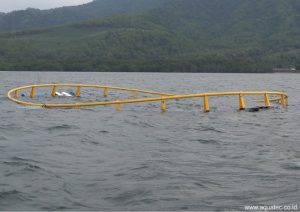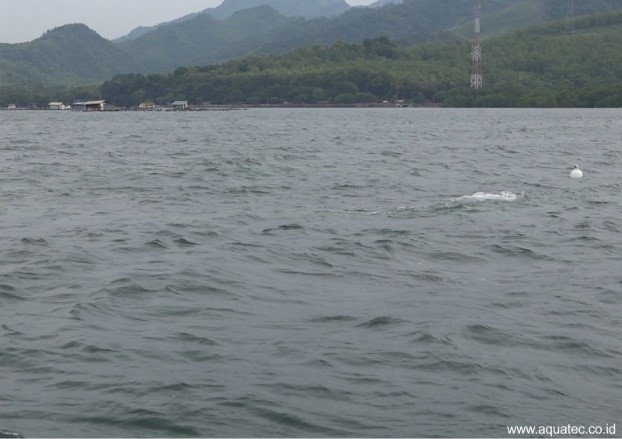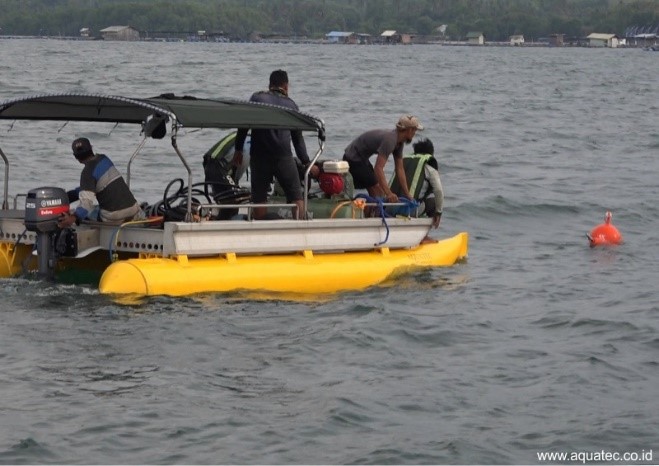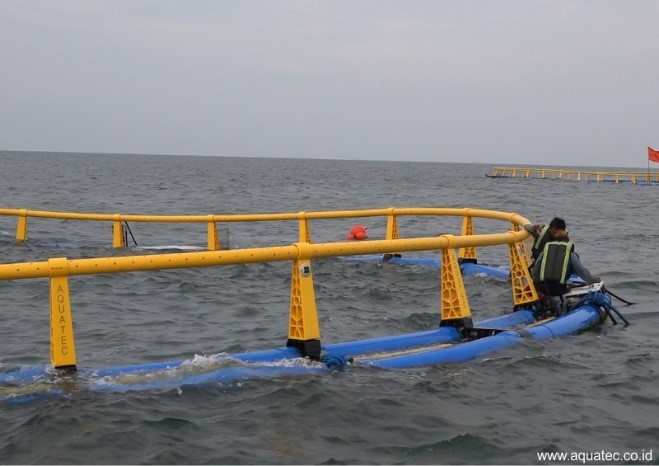Development of Offshore Submersible Marine Cage in South East Asia – Challenges and Success Stories
| Budiprawira Sunadim President Director PT. Gani Arta Dwitunggal  |
Andi Jayaprawira Sunadim Director of Aquatec® Division PT. Gani Arta Dwitunggal  |
BIOGRAPHIES
Budiprawira Sunadim
Budiprawira Sunadim was the founder of PT. Gani Arta in 1972, specializing in textile business. In 1993, he expanded the company and changed its name into PT. Gani Arta Dwitunggal, and began to diversify into HDPE netting. In 2008, the company further expanded to include the production of HDPE marine cage, HDPE floating dock, HDPE boats, and ecowood house. In 2015, Budiprawira began to develop a line of HDPE offshore submersible cages, focusing on the speed of operation, ease of use, durability, and low price of the submersible cage as its competitive edge.
Current duties and responsibilities:
– President Director of PT. Gani Arta Dwitunggal
– Head of Research and Development of PT. Gani Arta Dwitunggal
Andi Jayaprawira Sunadim
Andi Jayaprawira Sunadim joined PT. Gani Arta Dwitunggal in 2010 as General Manager. Since 2011 he held position as Director of Aquatec® Division.
Current duties and responsibilities:
– Director of Aquatec® Division (Marine and Aquaculture Division), PT. Gani Arta Dwitunggal
PAPER
1. INTRODUCTION
HDPE offshore submersible cage had been around in the market since the 2010s. However, million dollar price tag and slow operational speed caused this type of marine cage to see very limited usage. In this paper, the overview of the development of Aquatec® offshore submersible cage with affordable price and fast operational speed will be introduced.
2. BACKGROUND
In the field of aquaculture, especially offshore aquaculture, there are several obstacles that the fish farmers usually face, such as: 1) vicious waves and typhoon, 2) currents with high plankton level (plankton booming/red tide) which reduce the diluted oxygen level within a certain location, causing massive fish deaths, and 3) fish theft.
These obstacles are manageable by using a specific type of marine cage, the marine cage that is submersible and floatable as needed. By using this type of marine cage, known as the submersible cage, fish farmers will be able to: 1) avoid the vicious waves and typhoon by submerging the submersible cage when bad weather is about to come, then bringing it back to the surface once the weather is better, hence protecting the submersible cage from big waves and bad weather, 2) submerging the submersible cage when currents with high level of planktons is about to come (because such current is limited to 5m depth below the surface), and then bringing it back to surface after the current has passed, and 3) cultivating fish within a submerged submersible cage to prevent theft.
Those functions of the submersible cage enable the running of fish cultivation in open sea, therefore very useful for fish farmers. Right now there are two main models of submersible cage, one of which has a sphere like shape and the other one has a cylindrical net shape.
Submersible cage with sphere like shape is usually shaped as dodecahedron or icosahedron. Dodecahedron is a three dimensional sphere like shape that consists of 12 sided equilateral pentagons. This dodecahedron shape is usually used for sphere like shaped submersible cage with small to medium size. Icosahedron is a three dimensional sphere like shape that consists of 20 sided equilateral triangles. This icosahedron shape is usually used for sphere like shape submersible cage with large size, and the shape is more closely resembling a sphere than a dodecahedron.
A sphere like shaped submersible cage is made with the purpose of maximizing the volume of fish cultivation with efficient side area in order to save cost. Only, the cost to manufacture a sphere like shape submersible cage is quite high, with the manufacturing process requiring a number of equilateral pentagon or equilateral triangular panels that needed to be assembled to form a dodecahedron or an icosahedron. Those frames must have a high level strength especially at the corners, which are their critical points. These costs haven’t included the ballast. Therefore, the cost to acquire a sphere like shaped submersible cage is prohibitively high for some fish farmers.
Cylindrical submersible cage – or often called circular submersible cage because it has a circular shape when seen from the surface – on the other hand, only consists of two main frames, which are: 1) the upper net frame that functions as the submersible cage’s main body, 2) the lower net frame, and 3) ballast. The upper net frame consists of two or more HDPE pipe torus that are held together by a number of pipe connectors, on which fences and fence poles are also placed. The lower net frame consists of one or more HDPE pipe torus which are hanged on the upper net frame using stainless steel chains or Dyneema® ropes. These upper and lower net frames are easy to make and does not require a large amount of material like the sphere like shaped submersible cage. And as torus is one of the most stable shape to be used as the construction of the marine cage, the durability of the circular submersible cage is optimized. Therefore the cost of manufacturing the circular submersible cage is much lower than the cost of manufacturing the sphere like shaped submersible cage.
Finally, ballast is a component used to submerge and refloat the circular submersible cage to the surface. The ballast is the main mechanism to submerge and refloat the submersible cage. The ballast functions as a downward pulling force to counteract the buoyancy of the submersible cage, forcing the submersible cage to submerge. To refloat the submersible cage, a mechanism that counteract the downward pulling force of the ballast will cause the submersible cage to float back to the surface.
Submersible cages available in today’s market can be operated (time taken to submerge and refloat the sumbersible cage) within 1-2 hours. We deemed this operation time to be too long. One of Aquatec® main goals in manufacturing the circular submersible cage was to reduce the operation time. The purpose of this goal is to help the owner of our submersible cage to be able to respond to the news of coming typhoon more quickly, especially those who own a great number of cages. The other goals were to retain the net shape when the circular submersible cage is being submerged, and to make the submerging process to happen equally on all sides.
3. BASIC ENGINEERING
In order to reduce the submerge time, the upper net frame was made able to be filled with water to multiply the downward pulling force of the ballast. This mechanism alone reduces the need for a heavier ballast, and also hasten the submerging process of the submersible cage. By filling the upper net frame with water, submersible cage buoyancy is reduced in the submerging process, and therefore the submerging process becomes faster.
This mechanism poses new technical challenges as the upper net frame now required to have special valves and equipment. For submersible cage, pressure sensitive valves are used to control the flow of water into the upper net frame. The connection between the pressure sensitive valves and the HDPE pipe has to be completely waterproof under tremendous water pressure in order to ensure the durability of the submersible cage and equipment. Pressure equalizer is then installed to make sure the speed of water entering the upper net frame is equal on all sides of the upper net frame.
When in submerged condition, the net of the cylindrical submersible cage must retain its cylindrical shape, so that maximum net space is assured and cultivated fish do not feel cramped. In order to achieve it, the upper net frame needs to have leftover buoyancy spread equally on all sides so that there is an upward pulling force by the upper net frame that is less than the downward pulling force of the ballast. As the result, stainless steel chains or Dyneema® ropes connecting the upper net frame and the lower net frame are constantly in tension. With the upward pulling force of the upper net frame pulling the upper net frame upward and the downward pulling force of the ballast pulling the lower net frame downward, the net retains its perfect cylindrical shape.
A common occurrence that was seen in circular submersible cages available in the current market was: during the submerging process, one side of the circular submersible cage submerged first, followed by the opposite side of the submersible cage. This resulted in a temporary but significant loss of net space during the submerging process because the upper net frame was temporarily slanted, and as the result the cultivated fish underwent tremendous stress. This is not good for the wellbeing of the fish. To avoid this imbalance, a mechanism was implemented on Aquatec® offshore submersible cage that enables the upper net frame to submerge equally on all sides, retaining cylindrical net shape during the submerging process.
Other improvements that were implemented in the construction of Aquatec® offshore submersible cage include: 1) using thick monoblock pipe connector and fence with cross branching structure for upper net frame’s main construction, made using 2100 tonnes HDPE injection machine, 2) using prime (new and unrecycled) HDPE as the main material of the submersible cage to ensure maximum tensile strength, durability, and recyclability, 3) further improvement in water flow and pressure balance.
The cross branching structure on pipe connector and fence was designed in order to provide the maximum possible strength and durability. Aquatec® offshore submersible cage has an estimated lifetime of at least 25 years. These improvements were made while keeping factors like ease of installation, ease of operation, and minimal maintenance in mind.

Fig. 1: Aquatec® offshore submersible cage (without net and anchor).

Fig. 2: Aquatec® offshore submersible cage and compression chamber mounted on catamaran in Situbondo, West Java.

Fig. 3: Aquatec® offshore submersible cage monoblock pipe connector and fence pole with cross branching structure.
The refloating process can be done by pumping air back into into the upper net frame using an air compression chamber mounted on a boat. The pressure controlled pumping of air into the upper net frame resulted in faster refloating process.
4. TESTS AND APPLICATIONS
The first test of Aquatec® offshore submersible cage was conducted in Lampung Marine Aquaculture Research Center in November 2016. The submersible cage was able to be submerged in approximately 15 minutes and refloated back in approximately 20 minutes. One aspect that slowed the operation time was the uneven water flow when the upper net frame was being filled with water. Improvement in water flow through certain adjustment would further reduce the operation time of the submersible cage.
The second, third, and fourth test of the submersible cage were done simultaneously in Tulamben, Bali in January to February 2017 to test three different mechanism of improving water flow. As the result of the fourth test, the submersible cage can now be submerged in under 5 minutes and floated back in under 10 minutes, a significant improvement from the first test.
Furthermore, the submerging process of the submersible cage can now be done by simply opening the valves and can be left behind, with the submersible cage submerging by itself without supervision. This feature is useful for fish farmers that have a great number of submersible cage, as when the news of typhoon arrives, the process of submerging the submersible cages can be done at parallel by opening the valves of one submersible cage and then moving on to another submersible cage while the previous submersible cage submerge by itself. By submerging the submersible cages in parallel, a great number of Aquatec® offshore submersible cage can be submerged in very small window of time in response to a sudden news of typhoon.
The fifth test of the submersible cage was conducted in Hainan, China in August 2017 to test the 25m diameter (80m circumference) submersible cage real time against 9m typhoon which is known to regularly occur during August to September. The test result revealed that the submersible cage is unaffected by the typhoon when submerged.
The sixth test of the submersible cage was done in Situbondo, East Java as a joint research cooperation with Marine and Fishery Ministry of East Java in January 2018, and the product was deemed to be commercially available. Operable with 2 persons to both submerge and refloat the cage. No diver or special technician needed.
The following are the pictures of the sixth test of Aquatec® offshore submersible cage that was done in Situbondo. The submerging process was done in 5 minutes, and the refloating process was done in 10 minutes. Noted that the submerging process was operated by 2 persons, and happened equally on all sides of the cage, and the position of the upper net frame and lower net frame when in submerged condition would keep the net to retain perfect cylindrical shape.
 |
 |
| Fig. 4 and 5: The submerging process. Aquatec® offshore submersible cage submerged equally on all sides. Operable with 2 persons |
 |
 |
| Fig. 6 and 7: Submerging process complete. |
 |
 |
| Fig. 8 and 9: The refloating process. |
5. CONCLUSION
Implementing innovative methods on circular submersible cage resulted in a fast operating submersible cage with several useful features, It can effectively be used to avoid vicious waves and typhoon, plankton booming/red tide, and fish theft.
Furthermore, the resulting submersible cage is easy to install, easy to operate (operable with 2 persons, no diver or special technician needed), multiple cages can be submerged in parallel to respond to emergency situations quickly, and has low maintenance with an estimated lifetime of more than 25 years.
SOURCES
www.aquatec.co.id











